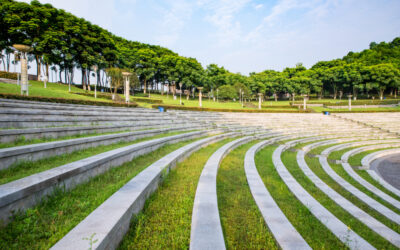How we benefit from our landscapes
In India, a land of stark diversity, the landscapes are imbued with a unique character, each telling its own story of heritage and culture. At Four Leaf Landscape, we strive to protect and enhance this diversity, creating spaces that not only please the eye but also nurture the soul. We believe in the power of landscaping to offer pleasant surroundings, promote health and well-being, and to serve as a canvas for memories and associations.
Our commitment to creating landscapes goes beyond aesthetics; it’s about instilling a sense of permanence and continuity in a rapidly changing world. We craft landscapes that are a haven for biodiversity, a platform for community regeneration, and a source of national pride. With each project, we aim to deliver scenic beauty, facilitate enjoyment and recreation, and provide educational value, all while ensuring sustainability and environmental stewardship.
Join us on a journey to explore the myriad benefits that landscapes offer. Let’s delve into how, through thoughtful design and meticulous care, landscapes can enhance your quality of life, contribute to community well-being, and become an integral part of India’s vibrant tapestry.
The Profound Impact of Landscaping on Daily Life and Culture
Landscapes are the canvas on which the story of our lives is painted. They are constant yet ever-changing, reflecting the passage of time and the rhythm of nature. In the bustling cities and tranquil countryside of India, Four Leaf Landscape works tirelessly to ensure that this canvas supports a rich and vibrant quality of life for all.
Quality of Life Elevated Through Landscaping
Imagine stepping outside to a world where greenery soothes your senses and open spaces invite you to breathe deeply. Landscapes designed by Four Leaf Landscape provide an environment that enhances the daily lives of people by offering a respite from the hustle and bustle of city life. Our landscapes are havens of tranquility, where beauty and functionality merge to create spaces for relaxation, play, and social interaction.
Sustaining History and Culture Through Landscapes
Our landscapes serve as custodians of memories, preserving the echoes of the past while embracing the pulse of the present. Four Leaf Landscape acknowledges the profound role landscapes play in maintaining the cultural fabric of India. We craft our projects with a deep respect for the history and traditions that have shaped the land, ensuring that every design is a tribute to the rich tapestry of Indian heritage.
Wellness and Community: A Landscaping Promise
The link between landscapes and well-being is undeniable. At Four Leaf Landscape, we curate environments that foster health, happiness, and community spirit. Our projects are not just about planting trees or installing water features; they’re about creating ecosystems that promote active lifestyles, community bonding, and a deep-seated sense of belonging.
Landscaping as a Conduit for Education and Growth
Four Leaf Landscape views every garden, park, and green space as a living classroom. The landscapes we create are rich with educational opportunities, offering insights into the flora, fauna, and ecosystems of India. We believe in empowering communities through knowledge, encouraging exploration and discovery within the natural world we help shape.
The Four Leaf Landscape Ethos: Blending Beauty with Responsibility
Our landscapes are statements of our commitment to environmental responsibility and sustainable practices. We design with the future in mind, ensuring that the landscapes of today will endure for generations to come. Four Leaf Landscape takes pride in leading the way toward a greener, more sustainable future, where landscapes are not just seen but felt, experienced, and treasured.
In conclusion, the landscapes we enjoy today are gifts that keep on giving. They are living legacies that Four Leaf Landscape is proud to design, build, and maintain. As the best landscaping company in India, we invite you to experience the full spectrum of benefits that our landscapes can bring to your life and the world around you.
Pleasant surroundings and amenity
The attractiveness and amenity of our everyday landscapes are important for the quality of peoples lives.
Permanence and continuity
From a human perspective, many elements of the landscape are fixed or change very slowly providing a strong sense of place and reassurance.
Memories and associations
Individuals and communities may associate certain landscapes with particular experiences.
Diversity and character
The distinctiveness and character of our landscapes helps define a sense of place at both the local and regional level.
National identity
All of India’s landscapes are part of our national identity, but some project a sense of nationality and are considered national icons.
Scenic quality, beauty and aesthetics
Many of India’s rural landscapes are valued for their natural beauty and attractiveness. The aesthetic qualities and attractiveness of our townscapes and individual buildings are also important.
Health and well being
Attractive and accessible landscapes invite and encourage physical activity. They can provide escape from the pace of modern living and give us better insight into our past and culture. Closer engagement with them is therefore good for our individual health and well-being both mental and physical.
Community regeneration
Restoring degraded landscapes, engaging local people in their history and biodiversity and involving people more generally in decision making and management can also help build stronger communities.
Enjoyment and recreation
Our landscapes provide a very wide range of opportunities to enjoy the outdoors, ranging from local greenspace and urban parks through to remote mountains and coasts. All offer relaxation, challenge, and inspiration and an opportunity to experience first hand our natural and cultural heritage.
Education
In addition to providing a setting for contact with the natural world and built environment, our landscapes provide a vital record of our past and insight into people we were and places we lived. They provide a range of opportunities for learning about the natural and cultural heritage and also settings for formal and informal learning activity.




0 Comments